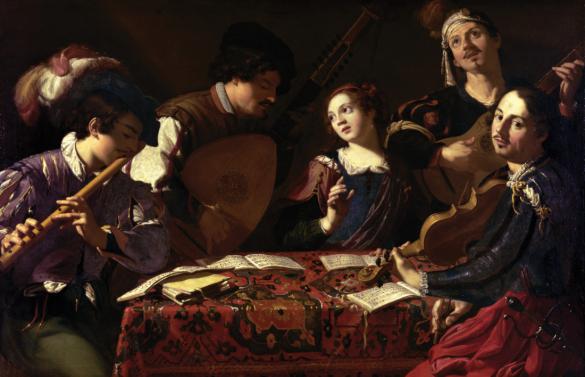Theodoor Rombouts studied in Italy from 1616 to 1625, following an apprenticeship in the vibrant and commercial city of Antwerp in the early seventeenth century. He was in Rome in 1620 and may have worked for the Medici in Florence until 1625, when he returned to Antwerp. Rombouts became a master at the Guild of St. Luke and embarked on a distinguished career producing mainly secular works for private patrons.
The Concert depicts a group of costumed musicians playing various instruments around a table covered with a Persian tapestry rug. Music parties of this type were typical subjects for Flemish artists during the seventeenth century. This painting shows the play of deep shadows and bright highlights that reflect the strong influence of the Italian Baroque artist Caravaggio (1571-1610), whose paintings Rombouts studied during his years in Rome. Caravaggio’s works were characterized by dramatic figures depicted with unflinching realism.
This music party is a celebration of the five senses. Rombouts indicates the various senses by selectively illuminating an ear, nose, hand, and eyes, but omits the sense of taste. This fifth sense may be represented by the foremost figure who looks out, inviting the viewer to complete the circle of senses and welcoming the patron of “good taste” who commissioned Rombouts’s paintings.




Are there any large prints available of the “The Concert” by Romburts? Thanks
We do not have any large prints of this piece. There are some similar pieces by the same artists at the website I have below, but not this exact piece. I am sorry I cannot be more helpful with this. https://www.allposters.com/-st/Theodor-Rombouts-Posters_c65732_.htm
[…] This music party is a celebration of the five senses. Rombouts indicates the various senses by selectively illuminating an ear, nose, hand, and eyes, but omits the sense of taste. This fifth sense may be represented by the foremost figure who looks out, inviting the viewer to complete the circle of senses and welcoming the patron of “good taste” who commissioned Rombouts’s paintings. The Cummer Museum […]